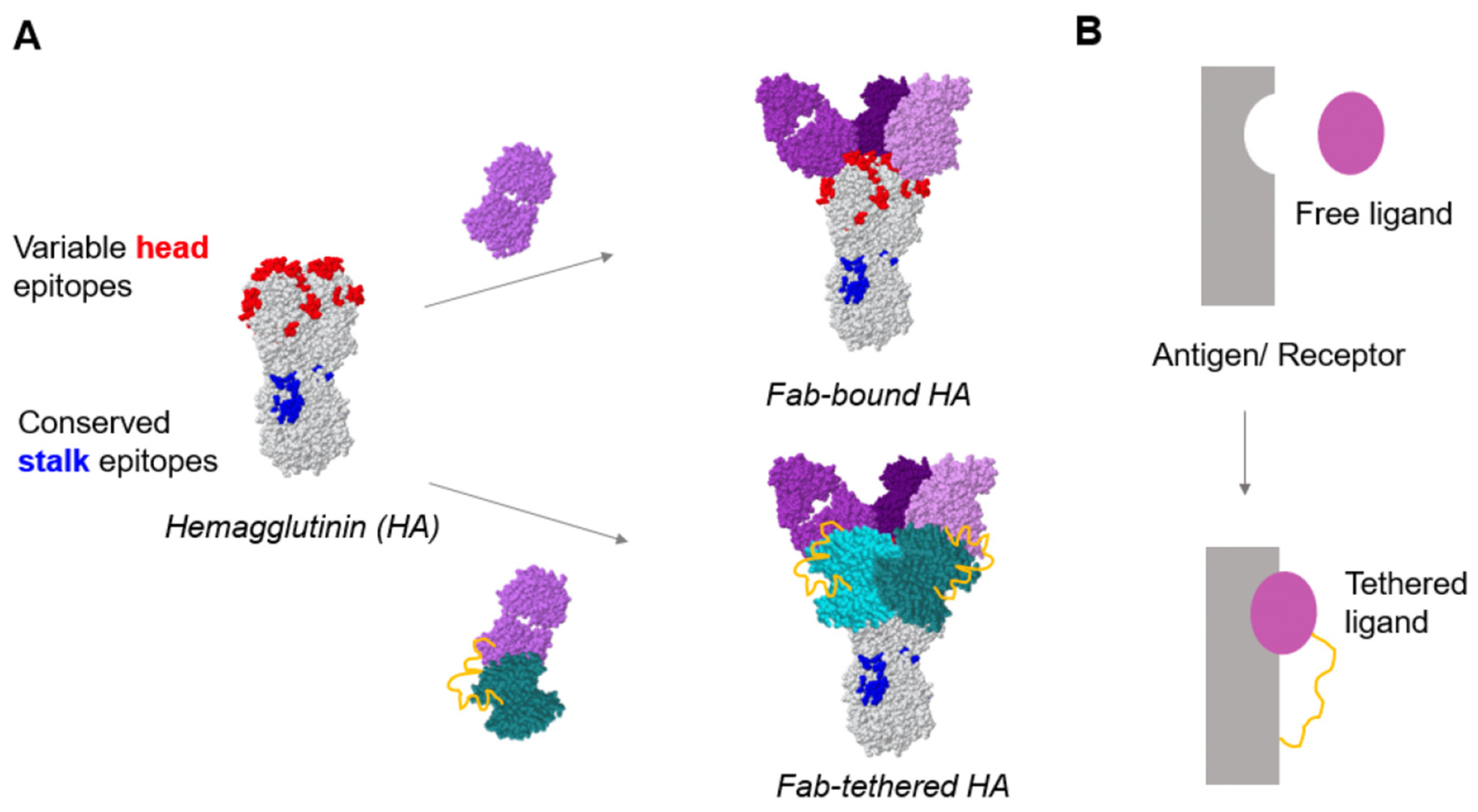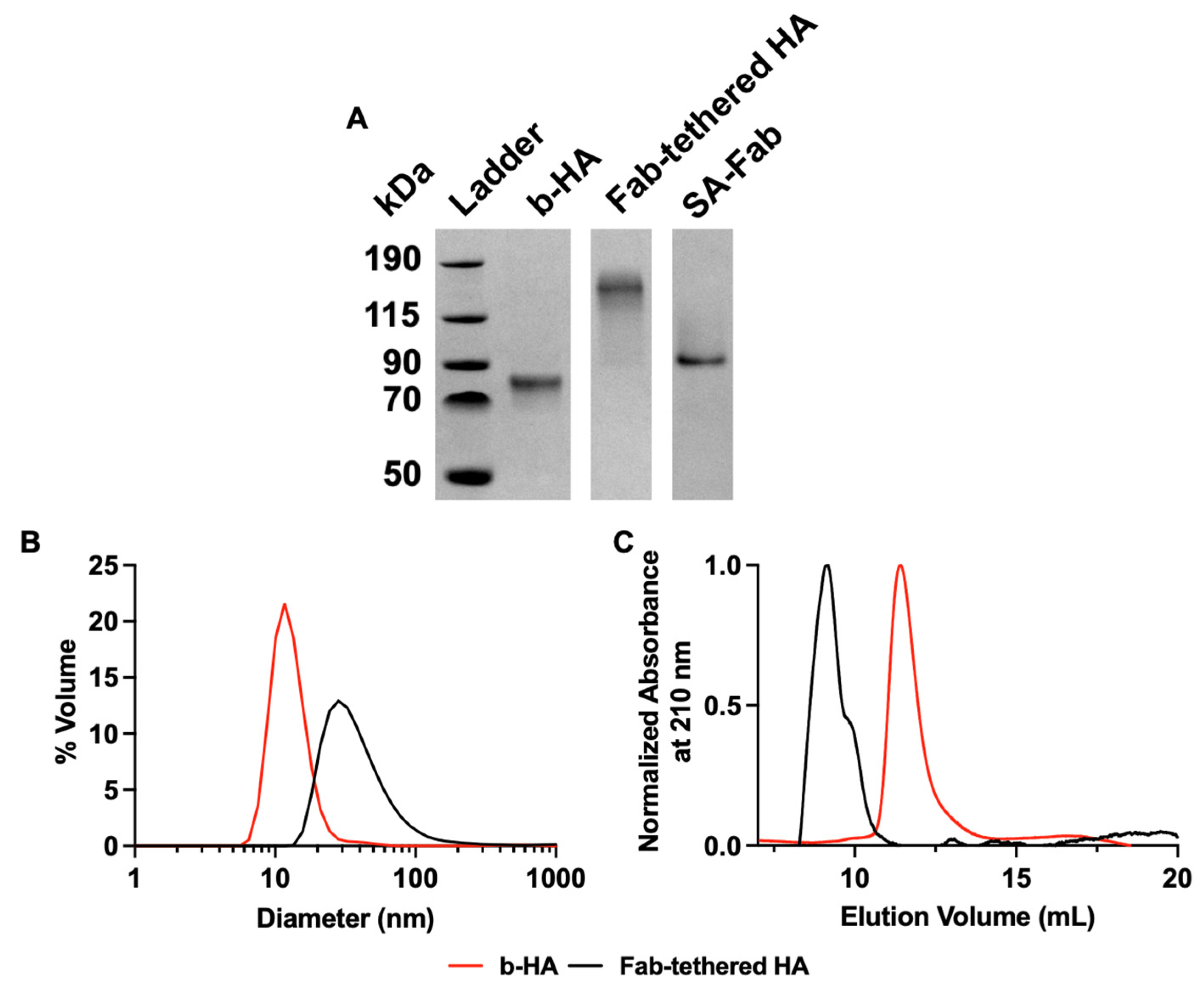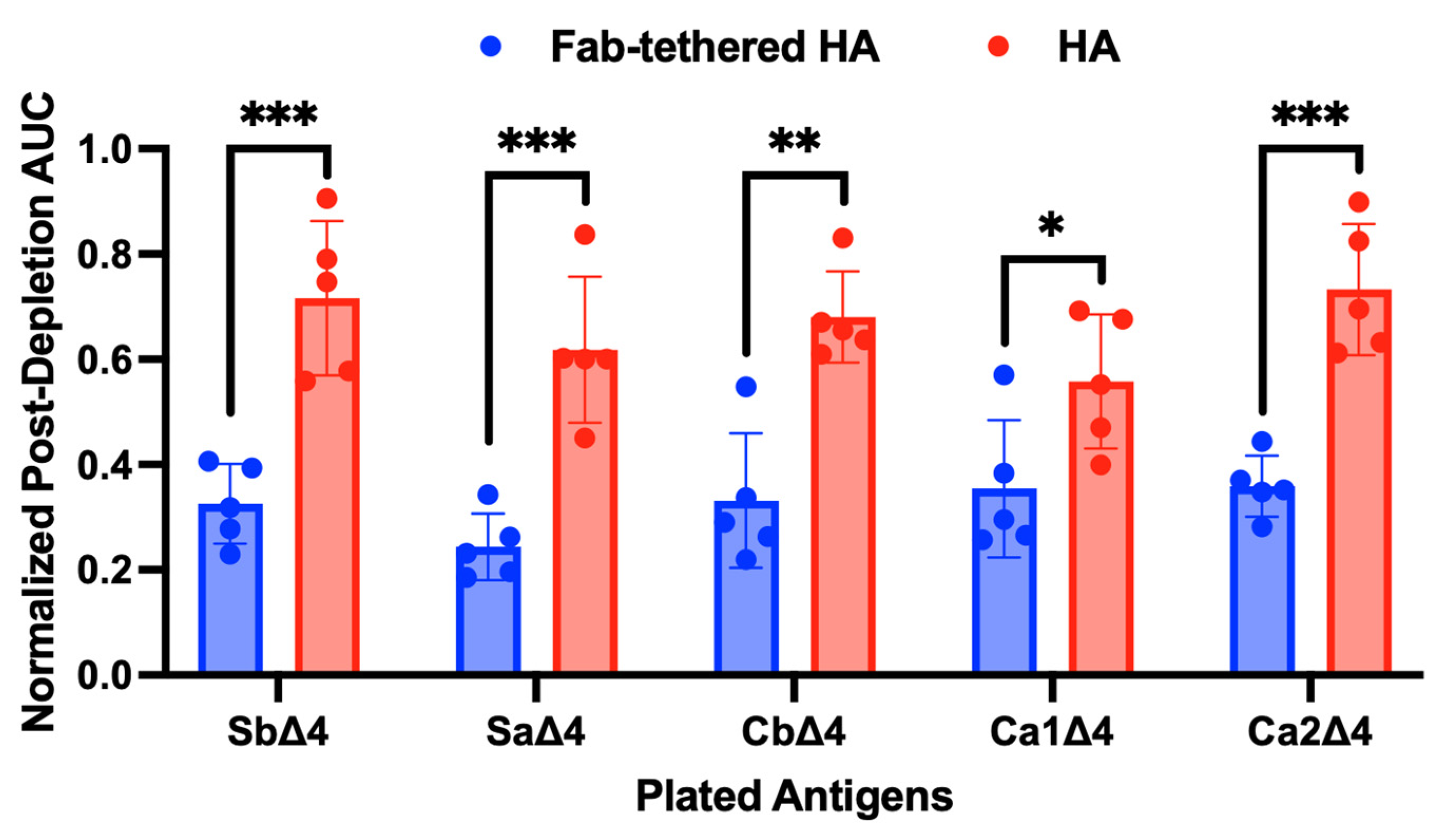Tethered Antigenic Suppression Shields the Hemagglutinin Head Domain and Refocuses the Antibody Response to the Stalk Domain
Abstract
1. Introduction
2. Materials and Methods
2.1. Expression and Purification of Avi-H28-D14 Fab
2.2. Expression and Purification of AviTagged HA
2.3. In Vitro Biotinylation of Avi-H28-D14 Fab and HA
2.4. Expression and Purification of Streptavidin (SA)
2.5. Assembly and Purification of SA-Fab from SA and b-H28-D14
2.6. Assembly of Fab-Tethered HA from SA-Fab and b-HA
2.7. Dynamic Light Scattering (DLS)
2.8. Expression and Purification of Regular HA
2.9. In Vivo Vaccination with Fab-Tethered HA and Regular HA
2.10. Expression and Purification of Δ4 HAs
2.11. Expression and Purification of Stalk-Only HA for Immunodepletion and ELISA
2.12. Immunodepletions
2.13. Enzyme-Linked Immunosorbent Assays (ELISA)
2.14. Avidity Assays
3. Results and Discussion
3.1. Assembly of Fab-Tethered HA
3.2. Immunization with Fab-Tethered HA and Characterization of Shielding of the HA Head Domain
4. Conclusions
Supplementary Materials
Author Contributions
Funding
Institutional Review Board Statement
Data Availability Statement
Conflicts of Interest
References
- Tyrrell, C.S.; Allen, J.L.Y.; Gkrania-Klotsas, E. Influenza: Epidemiology and hospital management. Medicine 2021, 49, 797–804. [Google Scholar] [CrossRef] [PubMed]
- Medina, R.A.; García-Sastre, A. Influenza A viruses: New research developments. Nat. Rev. Microbiol. 2011, 9, 590–603. [Google Scholar] [CrossRef] [PubMed]
- Margine, I.; Hai, R.; Albrecht Randy, A.; Obermoser, G.; Harrod, A.C.; Banchereau, J.; Palucka, K.; García-Sastre, A.; Palese, P.; Treanor John, J.; et al. H3N2 Influenza Virus Infection Induces Broadly Reactive Hemagglutinin Stalk Antibodies in Humans and Mice. J. Virol. 2013, 87, 4728–4737. [Google Scholar] [CrossRef] [PubMed]
- Moody, M.A.; Zhang, R.; Walter, E.B.; Woods, C.W.; Ginsburg, G.S.; McClain, M.T.; Denny, T.N.; Chen, X.; Munshaw, S.; Marshall, D.J.; et al. H3N2 Influenza Infection Elicits More Cross-Reactive and Less Clonally Expanded Anti-Hemagglutinin Antibodies Than Influenza Vaccination. PLoS ONE 2011, 6, e25797. [Google Scholar] [CrossRef] [PubMed]
- Wrammert, J.; Smith, K.; Miller, J.; Langley, W.A.; Kokko, K.; Larsen, C.; Zheng, N.-Y.; Mays, I.; Garman, L.; Helms, C.; et al. Rapid cloning of high-affinity human monoclonal antibodies against influenza virus. Nature 2008, 453, 667–671. [Google Scholar] [CrossRef]
- Krammer, F.; Palese, P. Universal influenza virus vaccines: Need for clinical trials. Nat. Immunol. 2014, 15, 3–5. [Google Scholar] [CrossRef]
- Taubenberger, J.K.; Morens, D.M. Influenza: The once and future pandemic. Public Health Rep. 2010, 125 (Suppl. S3), 16–26. [Google Scholar] [CrossRef]
- Eggink, D.; Goff Peter, H.; Palese, P. Guiding the Immune Response against Influenza Virus Hemagglutinin toward the Conserved Stalk Domain by Hyperglycosylation of the Globular Head Domain. J. Virol. 2014, 88, 699–704. [Google Scholar] [CrossRef]
- Impagliazzo, A.; Milder, F.; Kuipers, H.; Wagner, M.V.; Zhu, X.; Hoffman, R.M.B.; van Meersbergen, R.; Huizingh, J.; Wanningen, P.; Verspuij, J.; et al. A stable trimeric influenza hemagglutinin stem as a broadly protective immunogen. Science 2015, 349, 1301–1306. [Google Scholar] [CrossRef]
- Krammer, F.; Pica, N.; Hai, R.; Margine, I.; Palese, P. Chimeric Hemagglutinin Influenza Virus Vaccine Constructs Elicit Broadly Protective Stalk-Specific Antibodies. J. Virol. 2013, 87, 6542–6550. [Google Scholar] [CrossRef]
- Lu, Y.; Welsh, J.P.; Swartz, J.R. Production and stabilization of the trimeric influenza hemagglutinin stem domain for potentially broadly protective influenza vaccines. Proc. Natl. Acad. Sci. USA 2014, 111, 125–130. [Google Scholar] [CrossRef] [PubMed]
- Nachbagauer, R.; Feser, J.; Naficy, A.; Bernstein, D.I.; Guptill, J.; Walter, E.B.; Berlanda-Scorza, F.; Stadlbauer, D.; Wilson, P.C.; Aydillo, T.; et al. A chimeric hemagglutinin-based universal influenza virus vaccine approach induces broad and long-lasting immunity in a randomized, placebo-controlled phase I trial. Nat. Med. 2021, 27, 106–114. [Google Scholar] [CrossRef] [PubMed]
- Puente-Massaguer, E.; Vasilev, K.; Beyer, A.; Loganathan, M.; Francis, B.; Scherm, M.J.; Arunkumar, G.A.; González-Domínguez, I.; Zhu, X.; Wilson, I.A.; et al. Chimeric hemagglutinin split vaccines elicit broadly cross-reactive antibodies and protection against group 2 influenza viruses in mice. Sci. Adv. 2023, 9, eadi4753. [Google Scholar] [CrossRef] [PubMed]
- Yassine, H.M.; Boyington, J.C.; McTamney, P.M.; Wei, C.-J.; Kanekiyo, M.; Kong, W.-P.; Gallagher, J.R.; Wang, L.; Zhang, Y.; Joyce, M.G.; et al. Hemagglutinin-stem nanoparticles generate heterosubtypic influenza protection. Nat. Med. 2015, 21, 1065–1070. [Google Scholar] [CrossRef]
- Hariharan, V.; Kane, R.S. Glycosylation as a tool for rational vaccine design. Biotechnol. Bioeng. 2020, 117, 2556–2570. [Google Scholar] [CrossRef]
- Martina, C.E.; Crowe, J.E.; Meiler, J. Glycan masking in vaccine design: Targets, immunogens and applications. Front. Immunol. 2023, 14, 1126034. [Google Scholar] [CrossRef]
- Watanabe, Y.; Bowden, T.A.; Wilson, I.A.; Crispin, M. Exploitation of glycosylation in enveloped virus pathobiology. Biochim. Biophys. Acta (BBA) Gen. Subj. 2019, 1863, 1480–1497. [Google Scholar] [CrossRef]
- Angeletti, D.; Gibbs, J.S.; Angel, M.; Kosik, I.; Hickman, H.D.; Frank, G.M.; Das, S.R.; Wheatley, A.K.; Prabhakaran, M.; Leggat, D.J.; et al. Defining B cell immunodominance to viruses. Nat. Immunol. 2017, 18, 456–463. [Google Scholar] [CrossRef]
- Chen, Y.; Wilson, R.; O’Dell, S.; Guenaga, J.; Feng, Y.; Tran, K.; Chiang, C.-I.; Arendt, H.E.; DeStefano, J.; Mascola, J.R.; et al. An HIV-1 Env–Antibody Complex Focuses Antibody Responses to Conserved Neutralizing Epitopes. J. Immunol. 2016, 197, 3982–3998. [Google Scholar] [CrossRef]
- Kane, R.S. Thermodynamics of Multivalent Interactions: Influence of the Linker. Langmuir 2010, 26, 8636–8640. [Google Scholar] [CrossRef]
- Staudt, L.; Gerhard, W. Generation of antibody diversity in the immune response of BALB/c mice to influenza virus hemagglutinin. I. Significant variation in repertoire expression between individual mice. J. Exp. Med. 1983, 157, 687–704. [Google Scholar] [CrossRef] [PubMed]
- Fairhead, M.; Krndija, D.; Lowe, E.D.; Howarth, M. Plug-and-Play Pairing via Defined Divalent Streptavidins. J. Mol. Biol. 2014, 426, 199–214. [Google Scholar] [CrossRef] [PubMed]
- Frey, S.J.; Carreño, J.M.; Bielak, D.; Arsiwala, A.; Altomare, C.G.; Varner, C.; Rosen-Cheriyan, T.; Bajic, G.; Krammer, F.; Kane, R.S. Nanovaccines Displaying the Influenza Virus Hemagglutinin in an Inverted Orientation Elicit an Enhanced Stalk-Directed Antibody Response. Adv. Healthc. Mater. 2023, 12, 2202729. [Google Scholar] [CrossRef]
- Howarth, M.; Ting, A.Y. Imaging proteins in live mammalian cells with biotin ligase and monovalent streptavidin. Nat. Protoc. 2008, 3, 534–545. [Google Scholar] [CrossRef] [PubMed]
- Nguyen, T.-Q.; Rollon, R.; Choi, Y.-K. Animal Models for Influenza Research: Strengths and Weaknesses. Viruses 2021, 13, 1011. [Google Scholar] [CrossRef]
- Caro-Aguilar, I.; Rodríguez, A.; Calvo-Calle, J.M.; Guzmán, F.; Vega, P.D.L.; Patarroyo, M.E.; Galinski, M.R.; Moreno, A. Plasmodium vivax Promiscuous T-Helper Epitopes Defined and Evaluated as Linear Peptide Chimera Immunogens. Infect. Immun. 2002, 70, 3479–3492. [Google Scholar] [CrossRef]
- Singh, B.; Cabrera-Mora, M.; Jiang, J.; Galinski, M.; Moreno, A. Genetic linkage of autologous T cell epitopes in a chimeric recombinant construct improves anti-parasite and anti-disease protective effect of a malaria vaccine candidate. Vaccine 2010, 28, 2580–2592. [Google Scholar] [CrossRef]
- Caton, A.J.; Brownlee, G.G.; Yewdell, J.W.; Gerhard, W. The antigenic structure of the influenza virus A/PR/8/34 hemagglutinin (H1 subtype). Cell 1982, 31, 417–427. [Google Scholar] [CrossRef]





Disclaimer/Publisher’s Note: The statements, opinions and data contained in all publications are solely those of the individual author(s) and contributor(s) and not of MDPI and/or the editor(s). MDPI and/or the editor(s) disclaim responsibility for any injury to people or property resulting from any ideas, methods, instructions or products referred to in the content. |
© 2025 by the authors. Licensee MDPI, Basel, Switzerland. This article is an open access article distributed under the terms and conditions of the Creative Commons Attribution (CC BY) license (https://creativecommons.org/licenses/by/4.0/).
Share and Cite
Kim, D.; Loeffler, K.; Hu, Y.; Arsiwala, A.; Frey, S.; Murali, S.; Hariharan, V.; Moreno, A.; Kane, R.S. Tethered Antigenic Suppression Shields the Hemagglutinin Head Domain and Refocuses the Antibody Response to the Stalk Domain. Chemistry 2025, 7, 12. https://doi.org/10.3390/chemistry7010012
Kim D, Loeffler K, Hu Y, Arsiwala A, Frey S, Murali S, Hariharan V, Moreno A, Kane RS. Tethered Antigenic Suppression Shields the Hemagglutinin Head Domain and Refocuses the Antibody Response to the Stalk Domain. Chemistry. 2025; 7(1):12. https://doi.org/10.3390/chemistry7010012
Chicago/Turabian StyleKim, Donguk, Kathryn Loeffler, Yixin Hu, Ammar Arsiwala, Steven Frey, Shruthi Murali, Vivek Hariharan, Alberto Moreno, and Ravi S. Kane. 2025. "Tethered Antigenic Suppression Shields the Hemagglutinin Head Domain and Refocuses the Antibody Response to the Stalk Domain" Chemistry 7, no. 1: 12. https://doi.org/10.3390/chemistry7010012
APA StyleKim, D., Loeffler, K., Hu, Y., Arsiwala, A., Frey, S., Murali, S., Hariharan, V., Moreno, A., & Kane, R. S. (2025). Tethered Antigenic Suppression Shields the Hemagglutinin Head Domain and Refocuses the Antibody Response to the Stalk Domain. Chemistry, 7(1), 12. https://doi.org/10.3390/chemistry7010012







